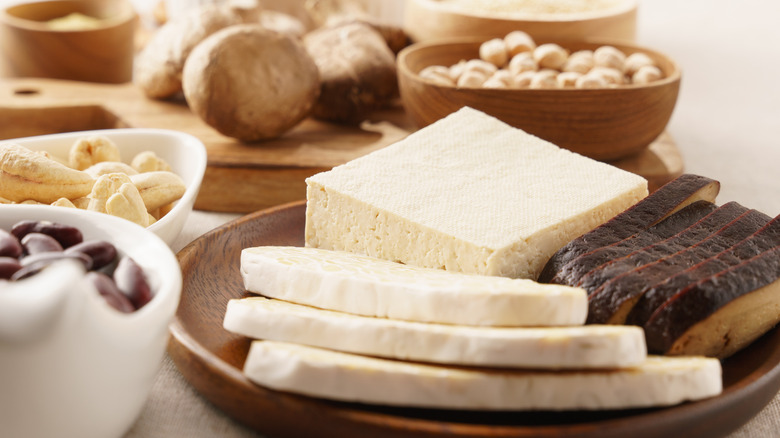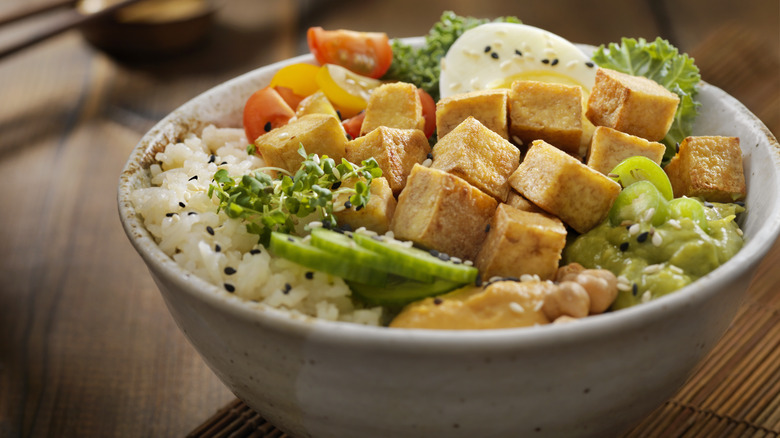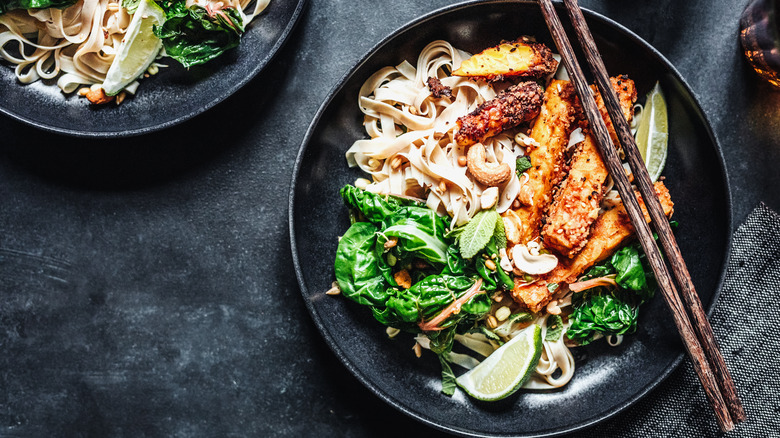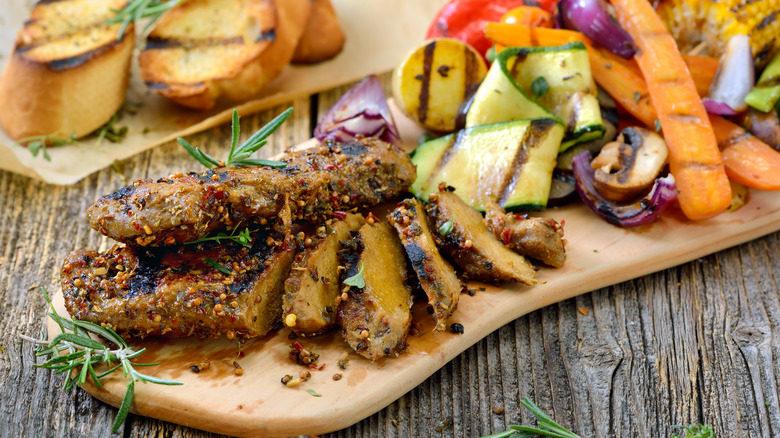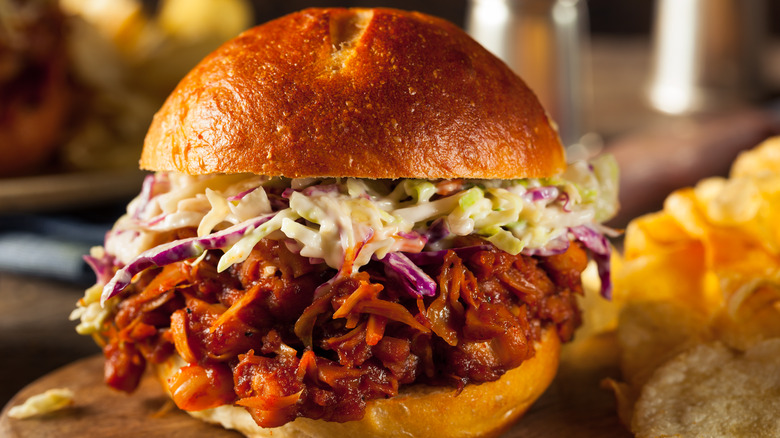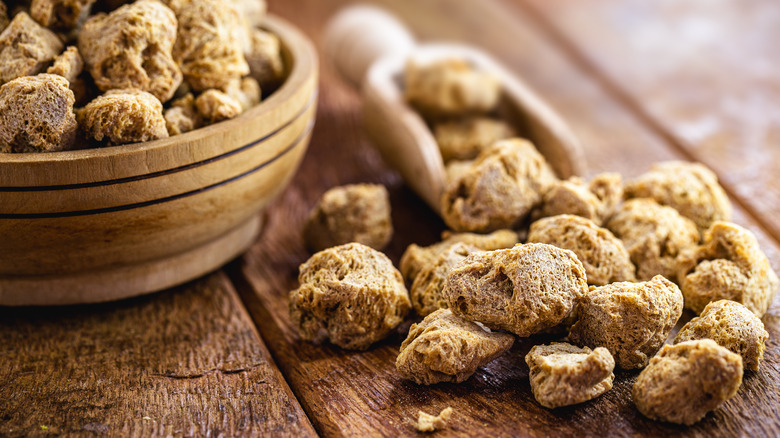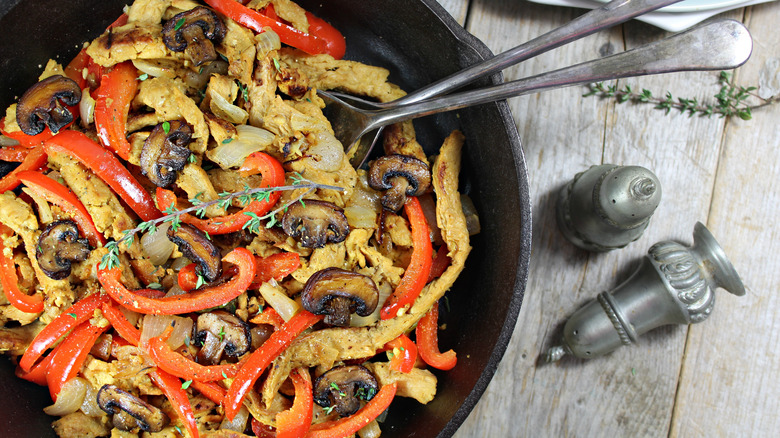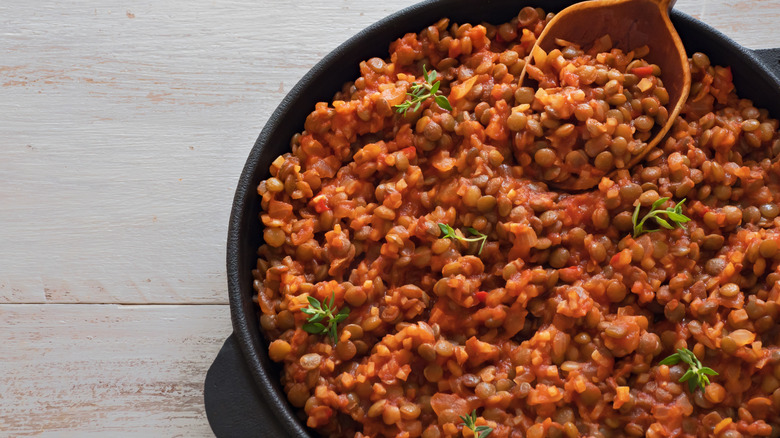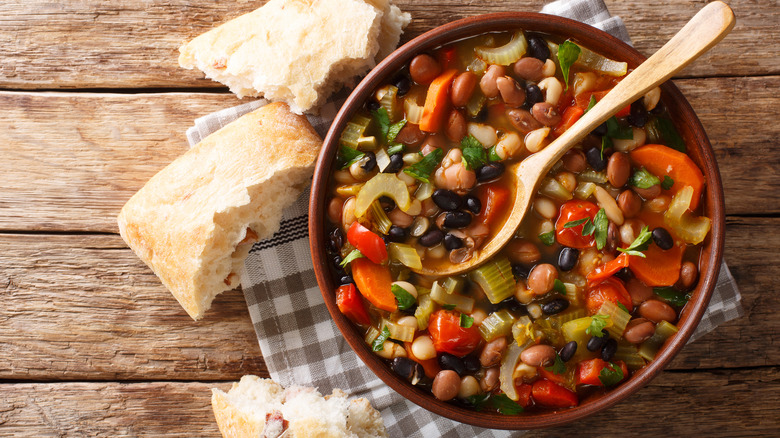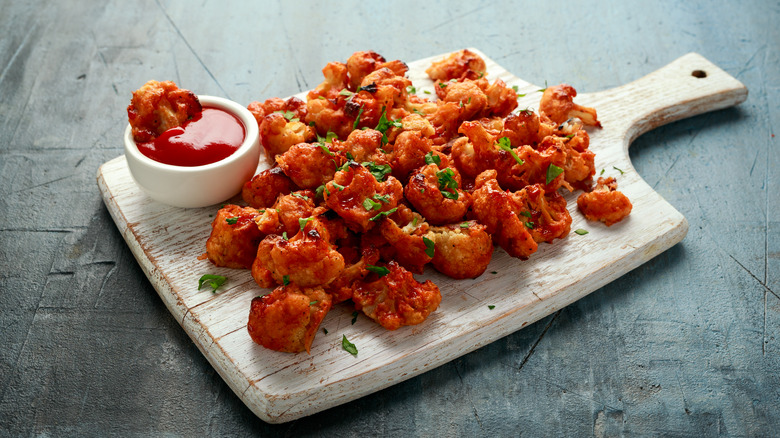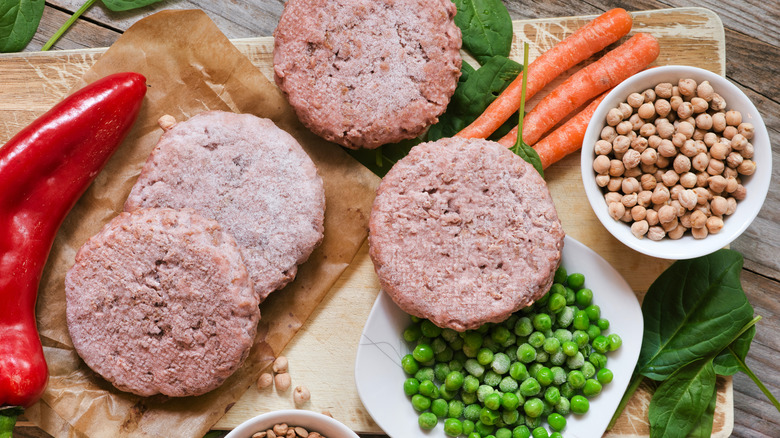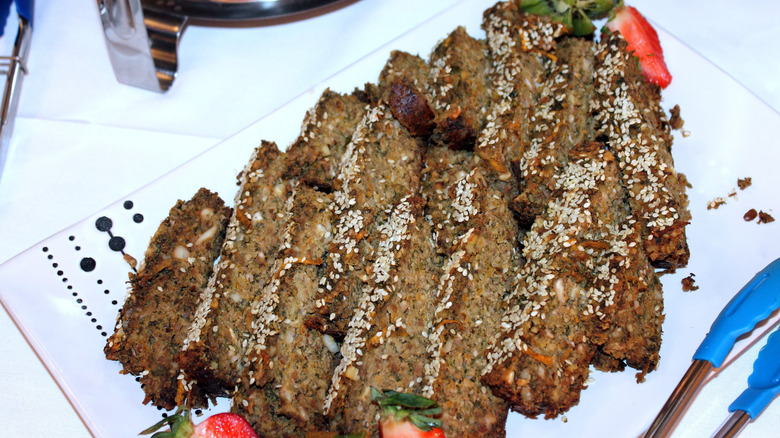13 Types Of Meat Substitutes And How To Use Them
Whether you're vegan, vegetarian, or just trying to eat fewer animal products, you might be wondering about meat substitutes. Perhaps you're not sure which to try, or maybe you've got a veggie friend or family member coming over for dinner and you're not sure how to adapt your favorite dishes. With so many meat substitute options available, it can seem overwhelming, but once you know more, you can narrow it down.
We're here to tell you about 13 types of meat substitutes and how to use them. From the holy trinity of tofu, tempeh, and seitan to commercial mock meats, and whole-food options like jackfruit and lentils, you have plenty to choose from. Some work better for certain dishes than others. For instance, brown lentils are great in recipes that usually call for ground beef, but you can't exactly use them instead of frankfurters in a hot dog bun. Others are quite versatile and can lend themselves to a range of recipes.
Don't listen to anyone who says that plant-based diets are boring or limited. There are so many ways that you can replace meat in recipes that you won't miss it. And even if a particular meat alternative doesn't taste like the ingredient it's replacing, it still brings its own flavor to the party.
1. Tofu
Tofu is an excellent, versatile meat substitute. No, it doesn't taste like meat, but it doesn't have to. Depending on the type of tofu and how it's cooked, it can have a firm, meaty texture — plus it brings protein to a dish that some veggie recipes can lack. You can basically use it in any recipe where you might have chunks, strips, or slices of meat, such as tacos, stir-fries, or curries. Smoked tofu is great to cut into small pieces and used as an alternative to speck or prosciutto in recipes such as carbonara.
There are so many ways to cook tofu — you can bake it, grill it, broil it, or fry it. The main thing to remember is to add enough flavor. Now, tofu gets a bad rap for being tasteless, and admittedly, it isn't all that flavorful on its own. But, you wouldn't generally serve unseasoned meat, either. Some recipes call for marinating tofu, but you can also achieve great results by coating tofu in seasoned flour or cornstarch and frying it.
You might have heard that many people call for pressing tofu before cooking it. Maybe this has put you off, as it seems like a complicated extra step. Well, the good news is you can absolutely get away with not pressing your tofu. Just blot the outside before cooking it and you'll still get deliciously crispy results.
2. Tempeh
Tempeh is tofu's more interesting cousin. It consists of soybeans fermented and held together in a dense cake of mold. This might sound off-putting at first, but it has a deep, complex flavor — and a little mold is nothing to be scared of in controlled conditions. After all, blue cheese is full of tasty mold spores. Tempeh comes from Indonesia, where it has been eaten for hundreds if not thousands of years (its exact date of invention is unclear).
It has a meatier, more toothsome texture than tofu, and has more flavor before seasoning. Though, as with most foods, you should still season it to get the most out of it. If you find the flavor of tempeh a little too intense or slightly bitter, some people swear by steaming the block it comes in for 5 to 10 minutes before prepping it and cooking it as desired.
Perhaps the most common way to cook tempeh is simply to pan-fry it until crispy. These pieces can be used in all kinds of dishes, from fried noodles to salads to pasta dishes. You can also roast or bake it, or process it into small chunks to use in place of ground beef. Marinating it before cooking helps give it extra flavor. Plus, there are many traditional Indonesian tempeh dishes you can try, such as gadon tempeh and pepes tempeh.
3. Seitan
Seitan is a type of meat substitute made using the gluten from wheat flour. It's been used for centuries in China and Japan, particularly in traditional Buddhist cuisine. It's traditionally made by forming a dough with flour and water, and then washing the dough to remove the starch from the dough, leaving behind just the gluten. This gluten is then simmered or steamed to cook it. However, today you can buy a product called vital wheat gluten, which is a kind of extremely high-gluten flour that acts as a shortcut to making seitan. It also allows for the addition of seasonings and other ingredients to the dough, so you can make more forms of seitan.
While you can buy some seitan products in stores, it's primarily a homemade affair. You can use it to make all kinds of homemade mock meats, including alternatives to bacon, ribs, burgers, sausages, pulled pork, chicken, roasted lamb, and steak. If you're willing to put in the time to make it yourself, it's one of the most versatile meat substitutes there is.
How exactly you cook with it depends on the type of mock meat you've decided to make. For instance, if you've made a chicken-style seitan, you might chop it into small chunks to use in a stir-fry or you could cut it into bigger pieces and southern fry it. Or if you made seitan bacon, you'd cut it into thin slices and fry it the way you'd fry bacon.
4. Commercial mock meats
Not only are commercial mock meats readily available in supermarkets and smaller grocery stores, but they're also super simple to prepare. While ingredients like tofu, tempeh, and seitan require preparation or careful seasoning to make the most of them, the types of meat replacements you can buy at the store are ready to cook (or even ready to eat cold, in the case of some items like deli meats).
What's cool about commercially available mock meats is that they come in all kinds of forms. You've got classic beef-style burger patties — like the Beyond Burger — or breaded chicken-style burgers if that's your preference. You can buy chicken nuggets and tenders, with popular options coming from Impossible Foods, Beyond Meat, and Quorn. Then you have chicken-style, beef-style, and pork-style pieces to use in recipes; Italian sausage that you can slice and cook with (as well as other types of sausage); veggie bacon; and so much more.
Basically, you can find a store-bought meat alternative from practically any type of meat. This makes it extremely simple to replace meat in existing recipes in your rotation when you're used to cooking with it. Just note that cooking times and methods can differ slightly from what you might be used to, so check the packaging to learn how to cook your chosen meat alternative.
5. Mushrooms
While mushrooms aren't going to look or taste especially like meat, this doesn't mean they don't make a good meat substitute in certain contexts. They're great if you prefer to use whole-food meat replacements over processed products. They also work especially well if you choose the variety of mushrooms and the type of recipe you use them in carefully.
King oyster mushrooms have a particularly firm, meaty texture, for instance. They have long, chunky stems that can be sliced to turn into jerky or bacon. You can also pull king oyster mushrooms to make a pulled pork alternative. Thanks to their large size, portobello mushrooms make great burger alternatives, while the firm, meaty texture of shiitake mushrooms makes them a top choice to use instead of meat in stir-fries, noodle dishes, and fried rice.
While they're rarely available commercially, if you can get your hands on some chicken of the woods mushrooms, you might be surprised how much they taste like chicken. They're ideal to use in place of chicken pieces in recipes or you can bread and fry them as an alternative to chicken tenders or chicken nuggets.
6. Jackfruit
You might have noticed jackfruit started to pop up as a plant-based option on menus in the last few years. If you've never had it, this can seem confusing. After all, how can a fruit be used as a meat alternative? Well, the thing to know about jackfruit is that its texture is quite stringy and meaty. It's quite similar in texture to pulled meats, which is why you'll often find it as a pulled pork alternative. What's more, when jackfruit is used as a meat alternative, it's in its unripe form. It has quite a neutral taste and isn't sweet or especially fruity. So, seasoned right, it takes on the flavors of the recipe.
So, how do you cook it? Jackfruit comes canned, so you just need to open it up and start to prepare it. For most recipes, it's pulled, which you can do with a fork, although you can chop it for a chunkier texture. Then, just follow the recipe. You'll usually pan-fry it with barbeque sauce or another marinade. It's a popular replacement for pulled pork, in buns, on nachos, or in tacos. However, it has more uses than this. Some people use it in combination with vital wheat gluten to make ribs, burgers, or similar. It lends a stringy, meaty texture to toothsome seitan.
7. Textured vegetable protein
If you were vegetarian in the '80s or '90s, you've almost definitely come across textured vegetable protein — or TVP, as it's more commonly known. It's most commonly made out of soybeans, as it can be formed from a protein-rich paste that's a by-product of the soybean oil production process.
But, what is TVP? It's essentially a dried product that can be rehydrated to use as a meat alternative. It usually comes in strips, chunks, or small pieces that act as a ground beef alternative. You rehydrate it in hot water or broth, with seasonings of your choice, before adding it to dishes. Chunks or strips are best rehydrated in a flavorful broth before being squeezed out, so they aren't soggy and added to dishes like curries, stews, or stir-fries. The ground beef-like pieces can either be hydrated in stock or directly in a sauce if it has enough liquid. For instance, you could just throw it straight into a simmering spaghetti sauce to make Bolognese.
TVP is cheap, convenient, and shelf-stable. However, that's about the nicest thing we have to say about it. The texture isn't great, and it often ends up quite tasteless. Is it good if you want something affordable and protein-rich? Yes. But is it our favorite meat substitute? Certainly not.
8. Soy curls
Soy curls are basically the cooler older sibling of TVP. Like TVP, they're dried and made from soybeans, but that's where the comparisons end. While TVP is made from the leftover by-products of soybean oil production, soy curls are made from the whole soybean. Not only does this mean they contain more fiber and protein, but they also just have a better flavor and texture. Texturally, soy curls are somewhere between tofu and processed mock meat. They're denser and less spongy than strips or chunks of TVP. They taste better, too, although they still need to be cooked with flavorful ingredients for you to get the most out of them.
Like TVP, you start by rehydrating them in water or broth. Then you need to squeeze out the excess moisture so they can absorb enough flavor. Next, you can either sauté them before coating them with a sauce and cook them further, or you can coat them in a sauce and put them in the oven to bake in the flavor. They're great in salads and sandwiches, on tacos, or basically anywhere else you might use strips of meat.
They can be a little tricky to find, though. They're generally only available online or in select health food stores. Depending on where you live, they might be widely available or near-impossible to find. And that's why I returned from Portland with five bags of soy curls stuffed in my suitcase.
9. Lentils
If you're looking for a cheap, whole-food-based ground beef alternative, lentils are the obvious option. Admittedly, they don't taste like ground beef, but their texture matches that of crumbled ground beef, and they can take on the flavors of the seasonings used in any dish, making them hugely versatile.
Green lentils and brown lentils make the best ground beef substitutes. This is not only because they hold their texture better than red lentils, but also because they have milder flavors. This makes them ideal blank canvases for all kinds of dishes. You can choose to either cook dried lentils to use in place of ground beef or to use precooked canned lentils.
To replace 1 pound of ground beef, use 1 cup of uncooked dried lentils or 2 ½ cups of cooked canned lentils. You can throw them straight into chilis or Bolognese sauce, or sauté them with spices to use as taco meat. Alternatively, you can squish them together to form foods like meatballs and burger patties.
10. Beans
While throwing beans into a stew, curry, or pasta sauce is going to give you a different flavor profile than using meat, there are other ways that beans take on this role. With their protein-rich nutrient profile, they make a good alternative to meat for anyone who's trying to get enough protein in their diet.
And some beans are particularly well-suited to replacing meat in recipes. For instance, mashed chickpeas mixed with mayo, veg, and seasonings make a good stand-in for chicken salad or tuna salad in sandwiches. Or you can roast beans with smoked paprika and other seasonings to make a stand-in for bacon bits. Their hearty texture is a good alternative to meat in chili recipes, too. You can also mash beans to use in bean burgers, bean balls, and other alternatives to processed meat dishes. Again, these dishes won't taste like meat, but they will be protein-packed, filling, and flavorful.
11. Cauliflower
You've probably seen cauliflower wings on menus for quite a while now, served as a plant-based alternative to Buffalo wings. We all know that cauliflower isn't going to taste like chicken, but if Buffalo wings are more about the crispy coating and the spicy sauce for you than the meat, cauliflower wings are an ideal alternative.
But this isn't the only way you can enjoy cauliflower as a meat alternative. Cauliflower steaks can make an excellent substitute for a meat steak. Again, it's not that you're expecting the flavor to be similar to a steak, but that it can play a similar role as the centerpiece of a meal with an array of tasty sides. Cauliflower also has a relatively neutral flavor that can take on a wide range of seasonings with delicious results. Plus, there are other great recipes that use cauliflower as a meat substitute, including cauliflower burgers and cauliflower taco meat. If you're looking for something fresh and non-processed, this is a nice choice of meat substitute.
12. Pea protein
Not only are peas incredibly protein-rich, but pea protein can be used to help mimic the textures and flavors of meats. That's why pea protein is a main ingredient in a lot of newer commercial mock meats, including Beyond Burgers. So, if you want to try mock meats based on pea protein, commercial pre-packed options are the easiest way to do this. They come in a range of forms — including burgers, sausages, and pieces — that you can cook and add to recipes in a similar way as the meats they're trying to replicate.
However, it's also possible to use pea protein to make your own mock meats at home if you want to experiment in the kitchen. First, you'll need to buy some pea protein isolate, which is commonly sold as a protein powder for building muscle. You'll then add seasonings to give it a meat-like flavor. These might include garlic powder, onion powder, herbs and spices, and perhaps faux chicken or beef stock powder. Next, you knead it to develop texture, before simmering, steaming, or baking to cook it. You can also add vital wheat gluten flour for a chewier, meatier texture.
13. Nuts
Like most of the whole-food meat substitutes on this list, you shouldn't expect nuts to taste identical to meat in a recipe, but they make good meat alternatives for other reasons. One is that they're highly nutritious. Nuts are rich in protein, fiber, and essential fatty acids, making them an important part of a balanced diet. They're also versatile enough to use in a range of recipes. And even if they won't be mistaken for meat, they still taste great and can bring a lot to the table.
Nut loaf is one way to use nuts as a meat alternative. It's become a bit of a vegetarian stereotype and doesn't have the best reputation, but it can be absolutely delicious when made well. A similar mixture can also be formed into mock meatballs. Then there's walnut meat, which is diced walnuts and mushrooms fried up with seasonings. It's used as an alternative to ground beef in dishes such as tacos, nachos, lasagna, or Bolognese.
